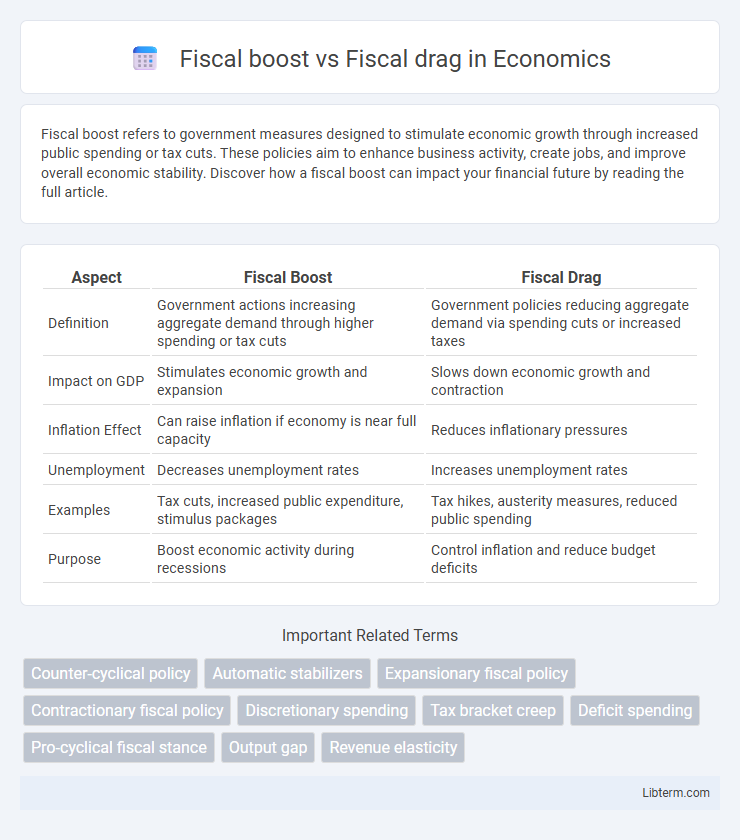Fiscal boost refers to government measures designed to stimulate economic growth through increased public spending or tax cuts. These policies aim to enhance business activity, create jobs, and improve overall economic stability. Discover how a fiscal boost can impact your financial future by reading the full article.
Table of Comparison
| Aspect | Fiscal Boost | Fiscal Drag |
|---|---|---|
| Definition | Government actions increasing aggregate demand through higher spending or tax cuts | Government policies reducing aggregate demand via spending cuts or increased taxes |
| Impact on GDP | Stimulates economic growth and expansion | Slows down economic growth and contraction |
| Inflation Effect | Can raise inflation if economy is near full capacity | Reduces inflationary pressures |
| Unemployment | Decreases unemployment rates | Increases unemployment rates |
| Examples | Tax cuts, increased public expenditure, stimulus packages | Tax hikes, austerity measures, reduced public spending |
| Purpose | Boost economic activity during recessions | Control inflation and reduce budget deficits |
Understanding Fiscal Boost and Fiscal Drag
Fiscal boost refers to government policies that increase aggregate demand by raising public spending or cutting taxes, stimulating economic growth and employment. Fiscal drag occurs when inflation pushes taxpayers into higher tax brackets without an actual increase in real income, reducing disposable income and dampening consumer spending. Understanding fiscal boost and fiscal drag is essential for assessing the impact of fiscal policy on economic cycles and inflation management.
Key Differences Between Fiscal Boost and Fiscal Drag
Fiscal boost stimulates economic growth through increased government spending or tax cuts, leading to higher aggregate demand. Fiscal drag occurs when rising taxes or reduced government spending slow economic activity by decreasing disposable income and consumption. The key difference lies in fiscal boost expanding economic output, while fiscal drag contracts it by influencing fiscal policy's impact on aggregate demand.
How Fiscal Policies Impact Economic Growth
Fiscal boost involves increased government spending or tax cuts that stimulate economic growth by raising aggregate demand and encouraging investment. Fiscal drag occurs when higher taxes or reduced government spending slow economic activity by decreasing disposable income and lowering consumer spending. The balance between these fiscal policies directly influences GDP growth, employment rates, and inflation by modulating the overall demand in the economy.
Mechanisms Behind Fiscal Boost
Fiscal boost occurs when government spending or tax cuts increase aggregate demand by directly injecting money into the economy, leading to higher consumer and business spending. The mechanism behind fiscal boost involves multiplier effects, where initial government expenditures create additional income and consumption, amplifying overall economic activity. This process contrasts with fiscal drag, where increased taxes or reduced spending withdraw money from the economy, slowing growth.
Causes and Effects of Fiscal Drag
Fiscal drag occurs when government tax revenues increase more rapidly than public incomes, often due to inflation pushing taxpayers into higher tax brackets, reducing disposable income and curbing consumer spending. This phenomenon leads to slower economic growth as households and businesses face higher effective tax rates without corresponding increases in real income. Causes include progressive tax structures and bracket creep, while effects manifest as reduced aggregate demand and potential dampening of investment and employment levels.
Historical Examples of Fiscal Boost Measures
Historical examples of fiscal boost measures include the New Deal programs in the 1930s United States, which increased government spending to combat the Great Depression by funding public works and social welfare projects. The 2009 American Recovery and Reinvestment Act (ARRA) injected approximately $831 billion into the U.S. economy through tax cuts, unemployment benefits, and infrastructure investments to counteract the Great Recession. Japan's fiscal stimulus packages in the 1990s and early 2000s, characterized by large government expenditures on public works, aimed to revive stagnating growth and deflationary pressures.
The Role of Taxation in Fiscal Drag
Fiscal drag occurs when inflation and income growth push taxpayers into higher tax brackets, increasing government revenue without changes to tax rates, effectively reducing disposable income and slowing economic growth. Taxation plays a central role in fiscal drag by automatically increasing the tax burden during economic expansion, which can dampen consumer spending and aggregate demand. Understanding this mechanism helps policymakers balance tax policies to avoid unintended restraints on economic momentum while maintaining fiscal health.
Fiscal Boost vs. Fiscal Drag: Implications for Businesses
Fiscal boost refers to increased government spending or tax cuts that stimulate economic growth, benefiting businesses through higher consumer demand and investment opportunities. Fiscal drag occurs when rising taxes or reduced government spending slow economic activity, leading to decreased business revenues and constrained growth potential. Understanding the balance between fiscal boost and fiscal drag is crucial for businesses to plan strategies, manage cash flow, and adapt to changing market conditions effectively.
Government Strategies to Manage Fiscal Drag
Government strategies to manage fiscal drag include adjusting tax brackets to prevent inflation from pushing taxpayers into higher tax rates, thereby minimizing the automatic increase in tax revenues. Policymakers often implement indexation of tax thresholds or provide targeted tax relief to sustain consumer spending and economic growth. These fiscal adjustments help maintain a balanced budget without stifling demand during periods of inflation or income growth.
Balancing Fiscal Policies for Sustainable Growth
Balancing fiscal policies for sustainable growth requires managing the effects of fiscal boost and fiscal drag to stabilize economic cycles. A fiscal boost, driven by increased government spending or tax cuts, stimulates aggregate demand and supports economic expansion during downturns. Conversely, fiscal drag occurs when rising taxes or reduced spending slow economic activity, helping to prevent overheating and inflation during periods of rapid growth.
Fiscal boost Infographic

 libterm.com
libterm.com